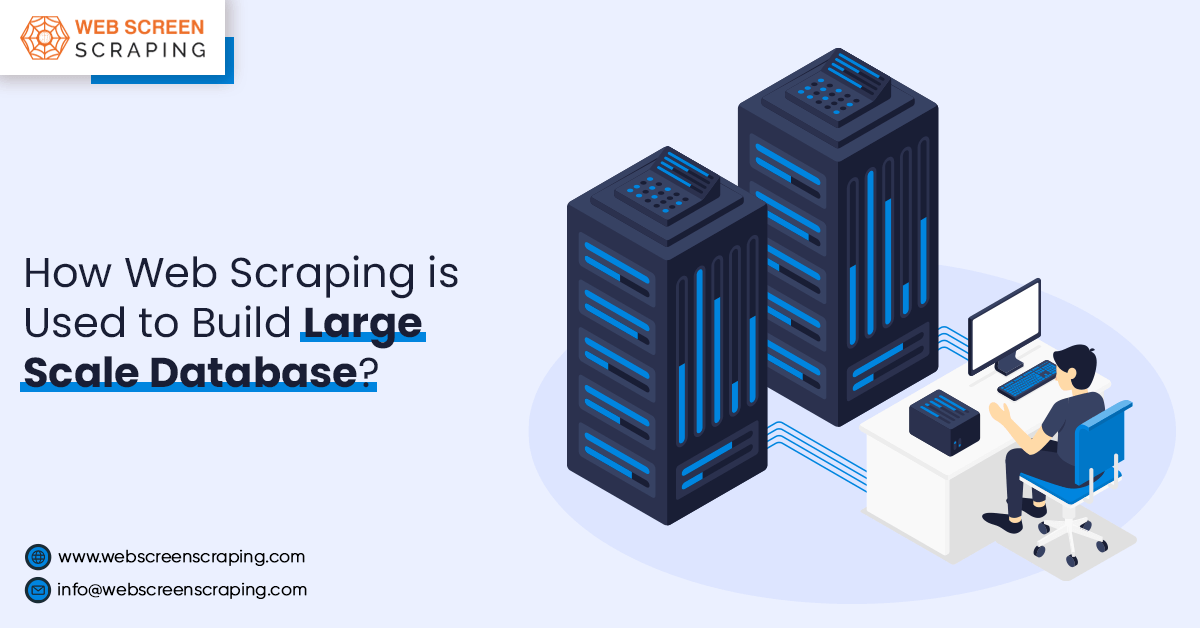There is less chance of success in business when organizations do not rely on data in this competitive and data-driven world. Online data that is freely accessible on different websites is one of the best sources of information, and to obtain the data, you must use data extraction services. Here we shall discuss some of the steps to take and the concerns to be aware of while conducting extensive web scraping.
It is difficult to build and maintain web scrapers which involves many resources like employees, plan, equipment, infrastructure, budget and skills. To run these scrapers continuously and incorporate the data you extract into your business process, you will probably need to hire a few engineers who are skilled at creating scalable crawlers and put up the servers and associated infrastructure.
You can hire full-service experts like Web Screen Scraping to handle all these for you.
Building Web Scrapers

Using one of the various web scraping tools and frameworks would be the ideal way to develop a web scraper. The next step is to pick a web scraping structure for the scrapers, such as Puppeteer (Javascript), PySpider, or Scrapy (Python).
The biggest justification for developing your web scraper is that you get freedom of working on it and do not remain dependent on developers for maintaining scrapers.
Visual data scraping tools to be used or not?

Visual web scraping solutions are simple to use and work well for fetching data from normal websites where much efforts are not required. So it is clear that visual scraping tools to be used when the data extraction is done from simple websites.
An open-source visual web scraping program that can handle complex websites has not been discovered till now if you need to perform extensive web scraping since the website is complicated you need to develop a scraper from scratch using Python programming language.
Top programing language used to build web scrapers

Python is advisable as it is the best programing language that can be used to build web scrapers or crawlers. Python was used to create Scrapy, the most widely used web scraping structure. It is ideal for data parsing and processing and has the most web scraping structures.
For scraping the majority of contemporary websites created using JavaScript structures like Angular, React, or VueJS, you may use tools like Selenium with Python. If you require superior skill, there is a large community that develops Python codes is available.
Using web scrapers for large scale data scraping

A big scale distributed scraping architecture that can scrape million pages and thousand websites per day is very different from creating and running one scraper that scrapes 100 pages.
Here are some pointers for efficiently operating web scrapers:
Architecture for Distributed Data Scraping

Some servers are required to make mechanism for distributing your scrapers across them, and a way to enable them to communicate with one another to scrape millions of pages every day. The following elements are necessary to make this happen:
Using a message broker like RabbitMQ, Redis, or Kafka, a data queue and a URL queue are used to distribute data and URLs across the scrapers that are executing on several servers. You can create scrapers that read URLs from a broker queue.
While this process is going on, execute another process and make data queue if the data scraping is on large scale otherwise write directly to database from scraper.
For restarting the scrapers scripts automatically, you require strong process management before the data is killed while parsing due to any reason.
Many of the abovementioned tasks can be avoided by using frameworks like PySpider and Scrapy -Redis.
Developing web scrapers for regularly updated data

In case you are supposed to periodically update data, you may either do it manually or use a tool to automate it. By using scrapyd + cron, Framework like scrapy will program the spiders and up-to-date data as and when needed. The interface to achieve this is similar in PySpider as well.
Large Databases for Records

You need a location to store this vast data collection once you get it. Depending on the frequency and speed of data scraping, we advise using a NoSQL database like Cassandra, MongoDB, or HBase to store this information.
After that, you can take the data out of the database and incorporate it into your business process. However, you should first build up some trustworthy QA tests for your data before doing it.
Use Proxies and IP Rotation

The anti-scraping tools and strategies are the greatest issues associated with large-scale scraping. There are many Screen Scraping Protection Solutions & Bot Mitigation, also known as anti-scraping tools, that prevent accessing websites from your scrapers. The IP ban method is typically used by companies like Distill Networks, Akamai, Perimeter X, Shield Square, etc.
Your servers' IP address will be immediately blacklisted if one of the IP address is already blocked. After being banned, the site won't react to the requests made by you from your servers or display a captcha, giving you some limited choices.
Considering that there are millions of inquiries, some points from following might be needed:
- If you aren't using a captcha or anti-scraping protection service, cycle your queries through more than 1000 proxies that are private.
- When interacting with the majority of anti-scraping solutions, send requests of around 100,000 geo proxies through a provider that aren't entirely blacklisted.
- alternatively, use reverse engineer that takes more resources and time and get beyond the anti-scraping measures.
Validation of Data and Quality Assurance

The quality of website data collected determines how useful it is. You must immediately perform several tests of quality assurance on the data you scraped to ensure that it is accurate and comprehensive. This helps in validating data before saving or processing it, especially when performing extensive web scraping.
It is important to have several tests for the data's integrity. Using Regular Expressions, you can mechanize portion of it by determining whether the data fits a determined pattern. If not, it should produce some alarms so that it may be manually examined.
You can validate the data record by using tools like Schema, Pandas, Cerebrus, etc. that are built on the Python programming language.
You can build up many steps in the channel if the scraper is one of them. Then use ETL Tools to check the data's accuracy and integrity.
Maintenance
data aggregators

Every website will be modified occasionally as per the need of organization, and your scrapers should do the same. Adjustments are typically required for every weeks or few months for website scrapers. Depending on the logic of your scraper, a little change in the target websites that affects the fields of data to scrape will result in missing data or cause the scraper to crash.
In order to verify the scrapers and the website for modifications that caused it, you need a technique to inform you if a large portion of the data extracted suddenly turns out to be empty or invalid. To avoid interruptions in your data flow, you must fix the scraper as soon as it breaks, using manual methods or by constructing ingenious algorithms that can do so quickly.
Storage and a Database

It's wise to prepare ahead if you're going to be performing extensive web scraping because you will need huge data storage. Spreadsheets and flat files are both suitable for storing small scale data. However, if the amount of data exceeds the capacity of a spreadsheet, you must consider other storage options, such as cloud storage and databases hosted in the cloud (S3, Azure Postgres, Azure SQL, Aurora, Redshift, RDS, Redis, DynamoDB,), relational databases (Oracle, MySQL, SQL Server), and no-SQL databases (Cassandra, MongoDB etc.).
You will need to delete obsolete data from your database in order to save money and space, depending on the quantity of the data. If you still require the outdated data, you can also wish to scale up the systems. Database replication and sharing can be useful.
After the scraping is finished, you must throw away useless data.
Conclusion
The extensive web scraping is time consuming and costly and one must be prepared to handle difficulties while doing the same. You must also know when to pause and get assistance. For many years, Web Screen Scraping has been performing all these tasks and more and have wide experience in developing scraper.
Looking for large-scale data scraping services? Contact Web Screen Scraping now!
Request for a quote!


